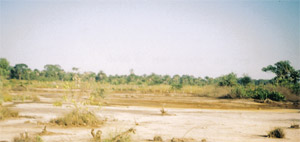Marakissa and Darsilami
Marakissa is another woodland area and was our first stop of the day. We were hoping for one particular species and failed to get it – more of that later. It was one of those mornings when, although the birds were good, we couldn't find anything new and some people began feeling a bit down. We did enjoy treetops containing a selection of male, female and juvenile sunbirds: Splendid, Variable and Beautiful, at least five Pied Hornbills, a male Northern Puffback, a Common Swift, Blackcap Babblers and, of course, Pearl-spotted Owlet – probably the easiest owl to see in the world!
There's a place by a river called Marakissa River Camp. Some of us sat on the roof terrace overlooking the river, some at the river's edge and some inside. Although it was the hottest part of the day we managed to fix up an umbrella for shade and, whilst eating lunch, check out what was using the river. Ospreys put in occasional appearances as did Great Egrets, Pied Kingfishers, Spur-winged and African Wattled Lapwings. A Common Greenshank and a Common Sandpiper fed along the river bank and African Darters flew past. We were delighted by a close Blue-spotted Wood-dove in the open in a tree and enjoyed soaring African Harrier-hawks. Mike had been sitting by the river bank checking everything that appeared and had seen a couple of Black Crakes and a sunbathing Giant Kingfisher. We managed to catch up with the crake later but the Giant 'Fisher didn't come past again.
After a few hours lounging around and eating, with some birding, we headed off to a nearby bridge over stream and some woodland. Pied-winged Swallows flew around the bridge and, in the woods, we had four Blue-bellied Rollers, two Shikras, seven African Green Pigeons, six Green Wood-hoopoes, a showing-well Yellow-throated Leaflove and a soaring Tawny Eagle (above, not in, the woods!).

Darsilami
Now we headed to a non-woodland habitat, almost on the southern border with Senegal, at Darsilami. This area is very open with cultivation and a river. There used to be a restaurant here but it was now just a ruin. There were hoped for species to be had here and we had a superb time. As we got off the landrovers we immediately had two Yellow-throated Longclaws on a nearby bush. Then a Plain-backed Pipit flew up and over and away, not stopping as we hoped. Then, after some risky crossing of muddy, steep-sided rice fields, we found two Yellow-mantled Widowbirds, one still with vestiges of the yellow on its mantle. Three new and good birds in a few minutes – this was now counted as a good place to stop!
We hadn't finished at Darsilami yet. The river held hawking Wire-tailed Swallows, Common Greenshank, one Marsh Sandpiper and Gull-billed Tern. An area of reeds/grasses had plenty of cisticolas, mostly Zitting but good views of some sitting up showed them to be Black-backed Cisticolas – another new bird. Six Little Bee-eaters and two soaring African Hawk Eagles finished off the visit but not the day's birding.
We intended to finish back at Marakissa woods. We stopped beneath a couple of open trees, open in that they didn't have many leaves so we could see any birds in them, and waited to see what would come past. First was an African Grey Hornbill soon followed by two White-crested Helmet-shrikes. Then came Red-eyed Dove and Green Wood-hoopoe and the much-wanted shout to say the bird we were seeking had arrived and a superb-looking adult White-breasted Cuckoo-shrike came into view. This bird was bigger than I had imagined and looked great. I know we had been waiting, effectively, all day for this bird but it was well worth it – both cuckoo-shrikes on the same trip, a very good record. It showed well for a while then flew off leaving many satisfied birders. To finish off we had yet another Pied Hornbill, African Thrush and 15 Piapiacs.

